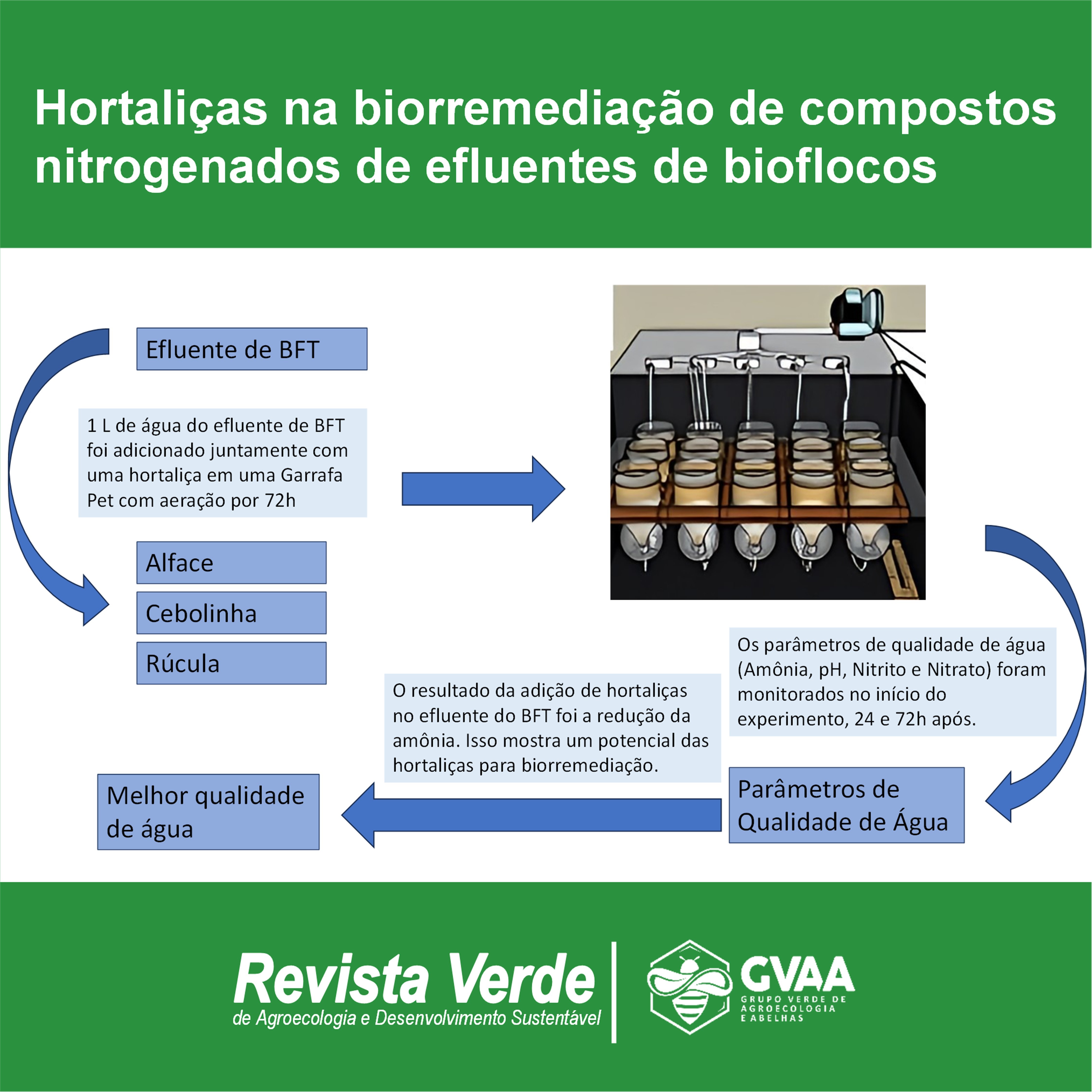Hortaliças na biorremediação de compostos nitrogenados de efluentes de bioflocos
DOI:
https://doi.org/10.18378/rvads.v19i1.9832Palavras-chave:
Amônia, Aquicultura, Nitrito, Nitrato, NitrificaçãoResumo
Nosso trabalho tem o objetivo de avaliar as alterações nos parâmetros de qualidade de água do efluente de um sistema de biofloco (BFT) após a inserção de hortaliças. Foram utilizadas mudas de hortaliças de três espécies: alface (Lactuca sativa), rúcula (Eruca sativa), e cebolinha verde (Allium schoenoprasum). Foram utilizadas 12 garrafas de politereftalato de etileno, divididas em quatro grupos (três diferentes hortaliças e controle), em triplicata, equipadas com sistema de aeração (individualmente) para evitar a sedimentação do BFT. As garrafas foram mantidas em uma caixa de polietileno (180L). As garrafas foram preenchidas com 1 L de água do BFT utilizada como amostra inicial (tempo zero). O pH, amônia total, nitrito e nitrato foram mensurados em tempo zero, 24 horas e 72 horas após a inserção das diferentes hortaliças no sistema experimental. Foi possível observar melhora nos níveis de amônia 24 h após a inserção das hortaliças, pois os tratamentos (Alface, Cebolinha e Rúcula) reduziram a quantidade de amônia quando comparado ao grupo controle. Entretanto, houve pouca influência sobre o pH, nitrito e nitrato. Portanto, podemos concluir que a inserção das hortaliças no efluente reduz os níveis de amônia, melhorando os parâmetros de qualidade de água e, portanto, podem reduzir o impacto ambiental ou atuar como biorremediadores do ambiente de cultivo.
Downloads
Referências
BOYD, C. E. Water quality: an introduction. Springer Nature, 2019.
EMERENCIANO, M.; GAXIOLA, G.; CUZON, G. Biofloc technology (BFT): a review for aquaculture application and animal food industry. Biomass Now-Cultivation and Utilization. Miodrag Darko Matovi Intech Open. InTech, Croatia, 2013. DOI: https://doi.org/10.5772/53902
EMERENCIANO, M.; MARTÍNEZ-CÓRDOVA, L. R.; MARTÍNEZ-PORCHAS, M.; MIRANDA-BAEZA, A. Biofloc technology (BFT): a tool for water quality management in aquaculture. In: Tutu H, editor. Water Quality. London (UK). 10.5772/66416
ESTRADA‐PEREZ, N.; HERNANDEZ-LLAMAS, A.; RUIZ-VELAZCO, J. M. J.; ZAVALA-LEAL, I.; ROMERO-BAÑUELOS, C. A.; CRUZ-CRESPO, E.; JUÁREZ-ROSSETE, C.; DOMÍNGUEZ-OJEDA, D.; CAMPOS-MENDOZA, A. Stochastic modelling of aquaponic production of tilapia (Oreochromis niloticus) with lettuce (Lactuca sativa) and cucumber (Cucumis sativus). Aquaculture Research, v. 49, n. 12, p. 3723-3734, 2018. 10.1111/are.13840 DOI: https://doi.org/10.1111/are.13840
ENDUT, A.; JUSOH, A.; ALI, N. A.; WAN NIK, W. B. Nutrient removal from aquaculture wastewater by vegetable production in aquaponics recirculation system. Desalination and water treatment, v. 32, n. 1-3, p. 422-430, 2011. 10.5004/dwt.2011.2761 DOI: https://doi.org/10.5004/dwt.2011.2761
FINK, M.; FELLER, C. An empirical model for describing growth and nitrogen uptake of white cabbage (Brassica oleracea var. capitata). Scientia horticulturae, v. 73, n. 2-3, p. 75-88, 1998. 10.1016/S0304-4238(97)00154-4 DOI: https://doi.org/10.1016/S0304-4238(97)00154-4
HU, Z.; LEE, J. W.; CHANDRAN, K.; KIM, S.; BROTTO, A. C.; KHANAL, S. K. Effect of plant species on nitrogen recovery in aquaponics. Bioresource technology, v. 188, p. 92-98, 2015. 10.1016/j.biortech.2015.01.013 DOI: https://doi.org/10.1016/j.biortech.2015.01.013
JATOBÁ. A.; BORGES, Y.V.; SILVA, F.A. BIOFLOC: sustainable alternative for water use in fishculture. Arquivo Brasileiro de Medicina Veterinária e Zootecnia, 71, 3, 1076-1080, 2019. 10.1590/1678-4162-10309 DOI: https://doi.org/10.1590/1678-4162-10309
JATOBÁ, A.; STOCKHAUSEN, L.; SILVA, L. R.; ANDRADE, J. I. A. Therapeutic bath of mint hydrolate in the control of monogenea for four tilapia species. Boletim do Instituto de Pesca, v. 49, 2023. 10.20950/1678-2305/bip.2023.49.e706 DOI: https://doi.org/10.20950/1678-2305/bip.2023.49.e706
KOTZEN, B.; EMERENCIANO, M.; MOHEIMANI, N.; BURNELL, G. M. Aquaponics: Alternative types and approaches. Aquaponics food production systems: Combined aquaculture and hydroponic production technologies for the future, p. 301-330, 2019. 10.1007/978-3-030-15943-6_12 DOI: https://doi.org/10.1007/978-3-030-15943-6_12
MARTINEZ-CORDOVA, L. R.; LÓPEZ-ELÍAS, J.; MARTINEZ-PORCHAS, M.; BRINGAS-BURGOS, B.; NARANJO-PARAMO, J. A preliminary evaluation of an integrated aquaculture-agriculture systems (tilapia and peppers) at mesocosm scale. J Aquac Mar Biol, v. 9, n. 1, p. 19-22, 2020. 10.15406/jamb.2020.09.00272 DOI: https://doi.org/10.15406/jamb.2020.09.00272
OLSSON, M. O.; FALKENGREN, U. G. Potential nitrification as an indicator of preferential uptake of ammonium or nitrate by plants in an oak woodland understorey. Annals of Botany, v. 85, n. 3, p. 299-305, 2000. 10.1006/anbo.1999.1075 DOI: https://doi.org/10.1006/anbo.1999.1075
PINHO, S. M.; DE LIMA, J. P.; TARIGAN, N. B.; DAVID, L. H.; PORTELLA, M. C.; KEESMAN, K. J. Modelling FLOCponics systems: Towards improved water and nitrogen use efficiency in biofloc-based fish culture. Biosystems Engineering, v. 229, p. 96-115, 2023. 10.1016/j.biosystemseng.2023.03.022 DOI: https://doi.org/10.1016/j.biosystemseng.2023.03.022
READ, P.; FERNANDES, T. Management of environmental impacts of marine aquaculture in Europe. Aquaculture, v. 226, n. 1-4, p. 139-163, 2003. 10.1016/S0044-8486(03)00474-5 DOI: https://doi.org/10.1016/S0044-8486(03)00474-5
SUMITRO, T. B.; FAUZI, H.; EKASARI, J. Production performance and nitrogen and phosphorus mass balance in biofloc-based African catfish intensive culture at different densities. Jurnal Akuakultur Indonesia, v. 20, n. 1, p. 82-92, 2021. 10.19027/jai.20.1.82-92 DOI: https://doi.org/10.19027/jai.20.1.82-92
VINATEA-ARANA, L. Princípios químicos de qualidade da água em aqüicultura. Florianópolis: Editora da UFSC, 1997.
WU, Y.; DUAN, Y.; WEI, Y.; AN, D.; LIU, J. Application of intelligent and unmanned equipment in aquaculture: A review. Computers and Electronics in Agriculture, v. 199, p. 107201, 2022. 10.1016/j.compag.2022.107201 DOI: https://doi.org/10.1016/j.compag.2022.107201
ZHOU, X.; WANG, J.; HUANG, L.; LI, D.; DUAN, Q. Modelling and controlling dissolved oxygen in recirculating aquaculture systems based on mechanism analysis and an adaptive PID controller. Computers and Electronics in Agriculture, v. 192, p. 106583, 2022. 10.1016/j.compag.2021.106583 DOI: https://doi.org/10.1016/j.compag.2021.106583

Downloads
Publicado
Como Citar
Edição
Seção
Licença
Copyright (c) 2023 Samantha Heiderscheidt et al.

Este trabalho está licenciado sob uma licença Creative Commons Attribution 4.0 International License.
Dados de financiamento
-
Conselho Nacional de Desenvolvimento Científico e Tecnológico
-
Fundação de Amparo à Pesquisa e Inovação do Estado de Santa Catarina
Números do Financiamento 2021TR000638










